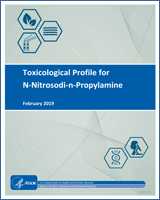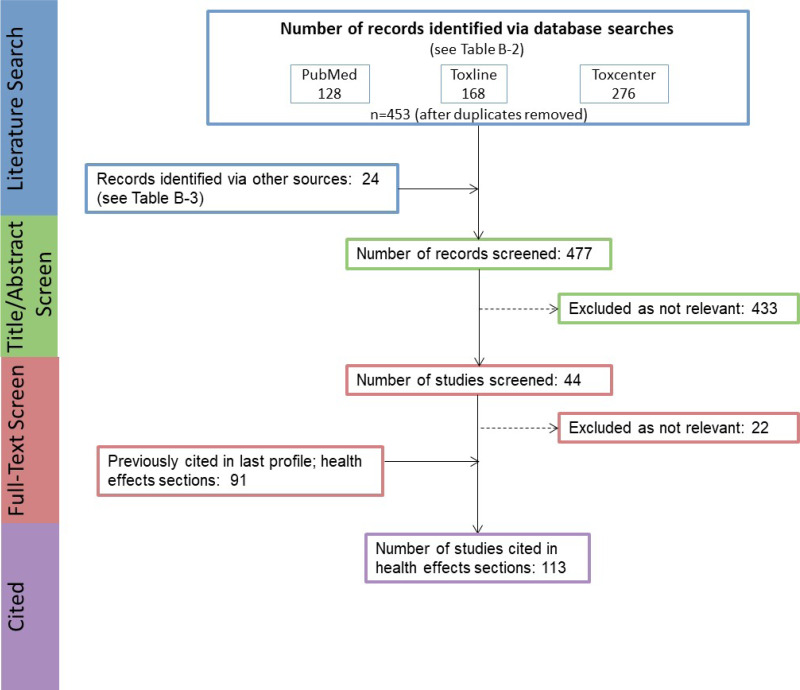NCBI Bookshelf. A service of the National Library of Medicine, National Institutes of Health.
Toxicological Profile for N-Nitrosodi-n-Propylamine. Atlanta (GA): Agency for Toxic Substances and Disease Registry (US); 2019 Feb.

Toxicological Profile for N-Nitrosodi-n-Propylamine.
Show detailsThe objective of the toxicological profile is to evaluate the potential for human exposure and the potential health hazards associated with inhalation, oral, or dermal/ocular exposure to N-nitrosodi-n-propylamine.
B.1. LITERATURE SEARCH AND SCREEN
A literature search and screen was conducted to identify studies examining health effects, toxicokinetics, mechanisms of action, susceptible populations, biomarkers, and chemical interactions data for N-nitrosodi-n-propylamine. ATSDR primarily focused on peer-reviewed articles without publication date or language restrictions. Non-peer-reviewed studies that were considered relevant to the assessment of the health effects of N-nitrosodi-n-propylamine have undergone peer review by at least three ATSDR-selected experts who have been screened for conflict of interest. The inclusion criteria used to identify relevant studies examining the health effects of N-nitrosodi-n-propylamine are presented in Table B-1.
Table B-1Inclusion Criteria for the Literature Search and Screen
|
Health Effects Species Human Laboratory mammals Route of exposure Inhalation Oral Dermal (or ocular) Parenteral (these studies will be considered supporting data) Health outcome Death Systemic effects Body weight effects Respiratory effects Cardiovascular effects Gastrointestinal effects Hematological effects Musculoskeletal effects Hepatic effects Renal effects Dermal effects Ocular effects Endocrine effects Immunological effects Neurological effects Reproductive effects Developmental effects Other noncancer effects Cancer |
|
Toxicokinetics Absorption Distribution Metabolism Excretion PBPK models Biomarkers Biomarkers of exposure Biomarkers of effect Interactions with other chemicals |
B.1.1. Literature Search
The current literature search was intended to update the health effects sections of the existing toxicological profile for N-nitrosodi-n-propylamine (ATSDR 1989), thus, the literature search was restricted to studies published between January 1987 to March 2017. The following main databases were searched in March 2017:
- PubMed
- National Library of Medicine’s TOXLINE
- Scientific and Technical Information Network’s TOXCENTER
The search strategy used the chemical names, Chemical Abstracts Service (CAS) numbers, synonyms, and Medical Subject Headings (MeSH) terms for N-nitrosodi-n-propylamine. The query strings used for the literature search are presented in Table B-2.
The search was augmented by searching the Toxic Substances Control Act Test Submissions (TSCATS), NTP website, and National Institute of Health Research Portfolio Online Reporting Tools Expenditures and Results (NIH RePORTER) databases using the queries presented in Table B-3. Additional databases were searched in the creation of various tables and figures, such as the TRI Explorer, the Substance priority list (SPL) resource page, and other items as needed. Regulations applicable to N-nitrosodi-N-propylamine were identified by searching international and U.S. agency websites and documents.
Review articles were identified and used for the purpose of providing background information and identifying additional references. ATSDR also identified reports from the grey literature, which included unpublished research reports, technical reports from government agencies, conference proceedings and abstracts, and theses and dissertations.
Table B-2Database Query Strings
| Database search date | Query string |
|---|---|
| PubMed | |
| 03/2017 | ((621-64-7[rn] OR 2920IH58NC[rn] OR “N-nitroso(di-n-propyl)amine”[supplementary concept] OR “N-nitroso(di-n-propyl)amine”[nm]) AND (1987/01/01 : 3000[dp] OR 1987/01/01 : 3000[mhda])) OR ((“N-Nitroso(di-n-propyl)amine”[tw] OR “Di-n-propylnitrosamine”[tw] OR “Di-n-propylnitrosoamine”[tw] OR “N-nitroso-Dipropylamine”[tw] OR “Dipropylnitrosamine”[tw] OR “N, N-Di-n-propylnitrosamine”[tw] OR “N, N-Dipropylnitrosamine”[tw] OR “N-Nitroso-N-propyl-1-propanamine”[tw] OR “N-Nitrosodi-n-propylamine”[tw] OR “N-Nitrosodipropylamine”[tw] OR “Nitrosodipropylamine”[tw] OR “N-nitroso-N-propyl-Propanamine”[tw] OR “N-nitroso-N-di-Propylamine”[tw]) AND (1987/01/01 : 3000[dp] OR 1987/01/01 : 3000[crdat] OR 1987/01/01 : 3000[edat])) |
| Toxline | |
| 03/2017 | ( “n-nitroso ( di-n-propyl ) amine” OR “di-n-propylnitrosamine” OR “di-n-propylnitrosoamine” OR “n-nitroso-dipropylamine” OR “dipropylnitrosamine” OR “n n-di-n-propylnitrosamine” OR “n n-dipropylnitrosamine” OR “n-nitroso-n-propyl-1-propanamine” OR “n-nitrosodi-n-propylamine” OR “n-nitrosodipropylamine” OR “nitrosodipropylamine” OR “n-nitroso-n-propyl-propanamine” OR “n-nitroso-n-di-propylamine” OR 621-64-7 [rn] ) AND 1987:2017 [yr] AND ( ANEUPL [org] OR BIOSIS [org] OR CIS [org] OR DART [org] OR EMIC [org] OR EPIDEM [org] OR HEEP [org] OR HMTC [org] OR IPA [org] OR RISKLINE [org] OR MTGABS [org] OR NIOSH [org] OR NTIS [org] OR PESTAB [org] OR PPBIB [org] ) AND NOT PubMed [org] AND NOT pubdart [org] |
| Toxcenter | |
| 03/2017 |
FILE ‘TOXCENTER’ ENTERED AT 12:44:25 ON 17 MAR 2017 CHARGED TO COST=EH011.13.01.01 L1 930 SEA 621-64-7 L2 915 SEA L1 NOT TSCATS/FS L3 901 SEA L2 NOT PATENT/DT L4 451 SEA L3 AND PY>=1987 ACTIVATE TOXQUERY/Q --------- L5 QUE (CHRONIC OR IMMUNOTOX? OR NEUROTOX? OR TOXICOKIN? OR BIOMARKER? OR NEUROLOG?) L6 QUE (PHARMACOKIN? OR SUBCHRONIC OR PBPK OR EPIDEMIOLOGY/ST,CT, IT) L7 QUE (ACUTE OR SUBACUTE OR LD50# OR LD(W)50 OR LC50# OR LC(W)50) L8 QUE (TOXICITY OR ADVERSE OR POISONING)/ST,CT,IT L9 QUE (INHAL? OR PULMON? OR NASAL? OR LUNG? OR RESPIR?) L10 QUE ((OCCUPATION? OR WORKPLACE? OR WORKER?) AND EXPOS?) L11 QUE (ORAL OR ORALLY OR INGEST? OR GAVAGE? OR DIET OR DIETS OR DIETARY OR DRINKING(W)WATER?) L12 QUE (MAXIMUM AND CONCENTRATION? AND (ALLOWABLE OR PERMISSIBLE)) L13 QUE (ABORT? OR ABNORMALIT? OR EMBRYO? OR CLEFT? OR FETUS?) L14 QUE (FOETUS? OR FETAL? OR FOETAL? OR FERTIL? OR MALFORM? OR OVUM?) L15 QUE (OVA OR OVARY OR PLACENTA? OR PREGNAN? OR PRENATAL?) L16 QUE (PERINATAL? OR POSTNATAL? OR REPRODUC? OR STERIL? OR TERATOGEN?) L17 QUE (SPERM OR SPERMAC? OR SPERMAG? OR SPERMATI? OR SPERMAS? OR SPERMATOB? OR SPERMATOC? OR SPERMATOG?) L18 QUE (SPERMATOI? OR SPERMATOL? OR SPERMATOR? OR SPERMATOX? OR SPERMATOZ? OR SPERMATU? OR SPERMI? OR SPERMO?) L19 QUE (NEONAT? OR NEWBORN? OR DEVELOPMENT OR DEVELOPMENTAL?) L20 QUE (ENDOCRIN? AND DISRUPT?) L21 QUE (ZYGOTE? OR CHILD OR CHILDREN OR ADOLESCEN? OR INFANT?) L22 QUE (WEAN? OR OFFSPRING OR AGE(W)FACTOR?) L23 QUE (DERMAL? OR DERMIS OR SKIN OR EPIDERM? OR CUTANEOUS?) L24 QUE (CARCINOG? OR COCARCINOG? OR CANCER? OR PRECANCER? OR NEOPLAS?) L25 QUE (TUMOR? OR TUMOUR? OR ONCOGEN? OR LYMPHOMA? OR CARCINOM?) L26 QUE (GENETOX? OR GENOTOX? OR MUTAGEN? OR GENETIC(W)TOXIC?) L27 QUE (NEPHROTOX? OR HEPATOTOX?) L28 QUE (ENDOCRIN? OR ESTROGEN? OR ANDROGEN? OR HORMON?) L29 QUE (OCCUPATION? OR WORKER? OR WORKPLACE? OR EPIDEM?) L30 QUE L5 OR L6 OR L7 OR L8 OR L9 OR L10 OR L11 OR L12 OR L13 OR L14 OR L15 OR L16 OR L17 OR L18 OR L19 OR L20 OR L21 OR L22 OR L23 OR L24 OR L25 OR L26 OR L27 OR L28 OR L29 L31 QUE (RAT OR RATS OR MOUSE OR MICE OR GUINEA(W)PIG? OR MURIDAE OR DOG OR DOGS OR RABBIT? OR HAMSTER? OR PIG OR PIGS OR SWINE OR PORCINE OR MONKEY? OR MACAQUE?) L32 QUE (MARMOSET? OR FERRET? OR GERBIL? OR RODENT? OR LAGOMORPHA OR BABOON? OR CANINE OR CAT OR CATS OR FELINE OR MURINE) L33 QUE L30 OR L31 OR L32 L34 QUE (NONHUMAN MAMMALS)/ORGN L35 QUE L33 OR L34 L36 QUE (HUMAN OR HUMANS OR HOMINIDAE OR MAMMALS OR MAMMAL? OR PRIMATES OR PRIMATE?) L37 QUE L35 OR L36 --------- L38 338 SEA L4 AND L37 L39 19 SEA L38 AND MEDLINE/FS L40 25 SEA L38 AND BIOSIS/FS L41 267 SEA L38 AND CAPLUS/FS L42 27 SEA L38 NOT (MEDLINE/FS OR BIOSIS/FS OR CAPLUS/FS) L43 295 DUP REM L39 L40 L42 L41 (43 DUPLICATES REMOVED) L*** DEL 19 S L38 AND MEDLINE/FS L*** DEL 19 S L38 AND MEDLINE/FS L44 19 SEA L43 L*** DEL 25 S L38 AND BIOSIS/FS L*** DEL 25 S L38 AND BIOSIS/FS L45 23 SEA L43 L*** DEL 267 S L38 AND CAPLUS/FS L*** DEL 267 S L38 AND CAPLUS/FS L46 235 SEA L43 L*** DEL 27 S L38 NOT (MEDLINE/FS OR BIOSIS/FS OR CAPLUS/FS) L*** DEL 27 S L38 NOT (MEDLINE/FS OR BIOSIS/FS OR CAPLUS/FS) L47 18 SEA L43 L48 276 SEA (L44 OR L45 OR L46 OR L47) NOT MEDLINE/FS SAVE TEMP L48 NITROSO/A D SCAN L48 |
Table B-3Strategies to Augment the Literature Search
| Source | Query and number screened when available |
|---|---|
| TSCATS a | |
| 03/2017 | Compound searched: 621-64-7 |
| NTP | |
| 03/2017 |
621-64-7 N-Nitroso(di-n-propyl)amine Di-n-propylnitrosamine Di-n-propylnitrosoamine N-nitroso-Dipropylamine Dipropylnitrosamine N,N-Di-n-propylnitrosamine N,N-Dipropylnitrosamine N-Nitroso-N-propyl-1-propanamine N-Nitrosodi-n-propylamine N-Nitrosodipropylamine Nitrosodipropylamine N-nitroso-N-propyl-Propanamine N-nitroso-N-di-Propylamine |
| NIH RePORTER | |
| 05/2017 |
Active projects “N-Nitroso(di-n-propyl)amine” OR “Di-n-propylnitrosamine” OR “Di-n-propylnitrosoamine” OR “N-nitroso-Dipropylamine” OR “Dipropylnitrosamine” OR “N,N-Di-n-propylnitrosamine” OR “N,N-Dipropylnitrosamine” OR “N-Nitroso-N-propyl-1-propanamine” OR “N-Nitrosodi-n-propylamine” OR “N-Nitrosodipropylamine” OR “Nitrosodipropylamine” OR “N-nitroso-N-propyl-Propanamine” OR “N-nitroso-N-di-Propylamine” |
| Other | Identified throughout the assessment process |
- a
Several versions of the TSCATS database were searched, as needed, by CASRN including TSCATS1 via Toxline (no date limit), TSCATS2 via https://yosemite
.epa .gov/oppts/epatscat8 .nsf/ReportSearch?OpenForm (date restricted by EPA receipt date), and TSCATS via CDAT (date restricted by ‘Mail Received Date Range’), as well as google for recent TSCA submissions.
The 2017 results were:
- Number of records identified from PubMed, TOXLINE, and TOXCENTER (after duplicate removal): 453
- Number of records identified from other strategies: 24
- Total number of records to undergo literature screening: 477
B.1.2. Literature Screening
A two-step process was used to screen the literature search to identify relevant studies on N-nitrosodi-N-propylamine:
- Title and abstract screen
- Full text screen
Title and Abstract Screen. Within the reference library, titles and abstracts were screened manually for relevance. Studies that were considered relevant (see Table B-1 for inclusion criteria) were moved to the second step of the literature screening process. Studies were excluded when the title and abstract clearly indicated that the study was not relevant to the toxicological profile.
- Number of titles and abstracts screened: 477
- Number of studies considered relevant and moved to the next step: 44
Full Text Screen. The second step in the literature screening process was a full text review of individual studies considered relevant in the title and abstract screen step. Each study was reviewed to determine whether it was relevant for inclusion in the toxicological profile.
- Number of studies undergoing full text review: 44
- Number of studies cited in the health effects sections of the existing toxicological profile (December, 1989): 91
- Total number of studies cited in the health effects sections of the updated profile: 113
A summary of the results of the literature search and screening is presented in Figure B-1.
- LITERATURE SEARCH FRAMEWORK FOR N-NITROSODI-n-PROPYLAMINE - Toxicological Profil...LITERATURE SEARCH FRAMEWORK FOR N-NITROSODI-n-PROPYLAMINE - Toxicological Profile for N-Nitrosodi-n-Propylamine
Your browsing activity is empty.
Activity recording is turned off.
See more...
